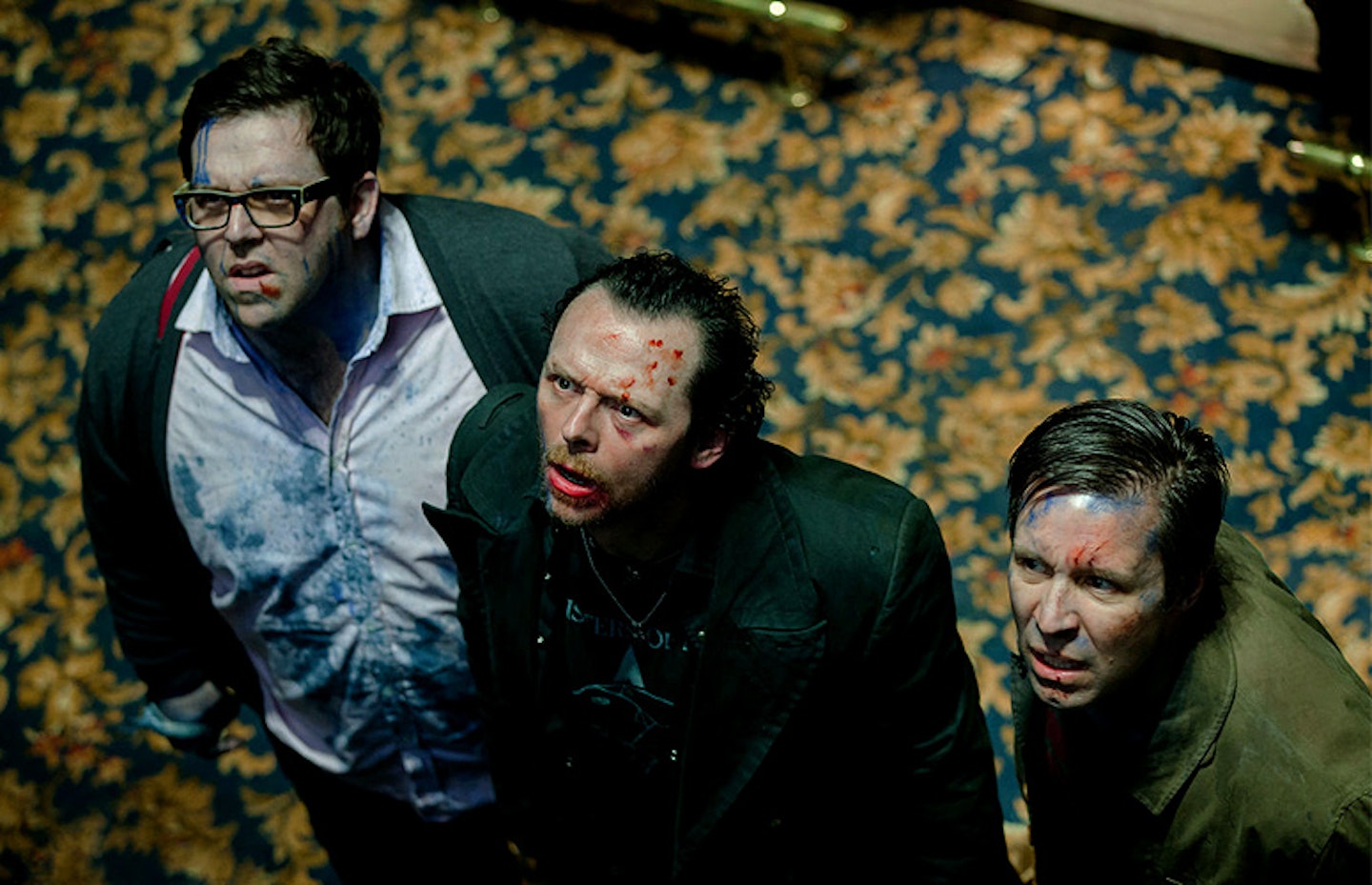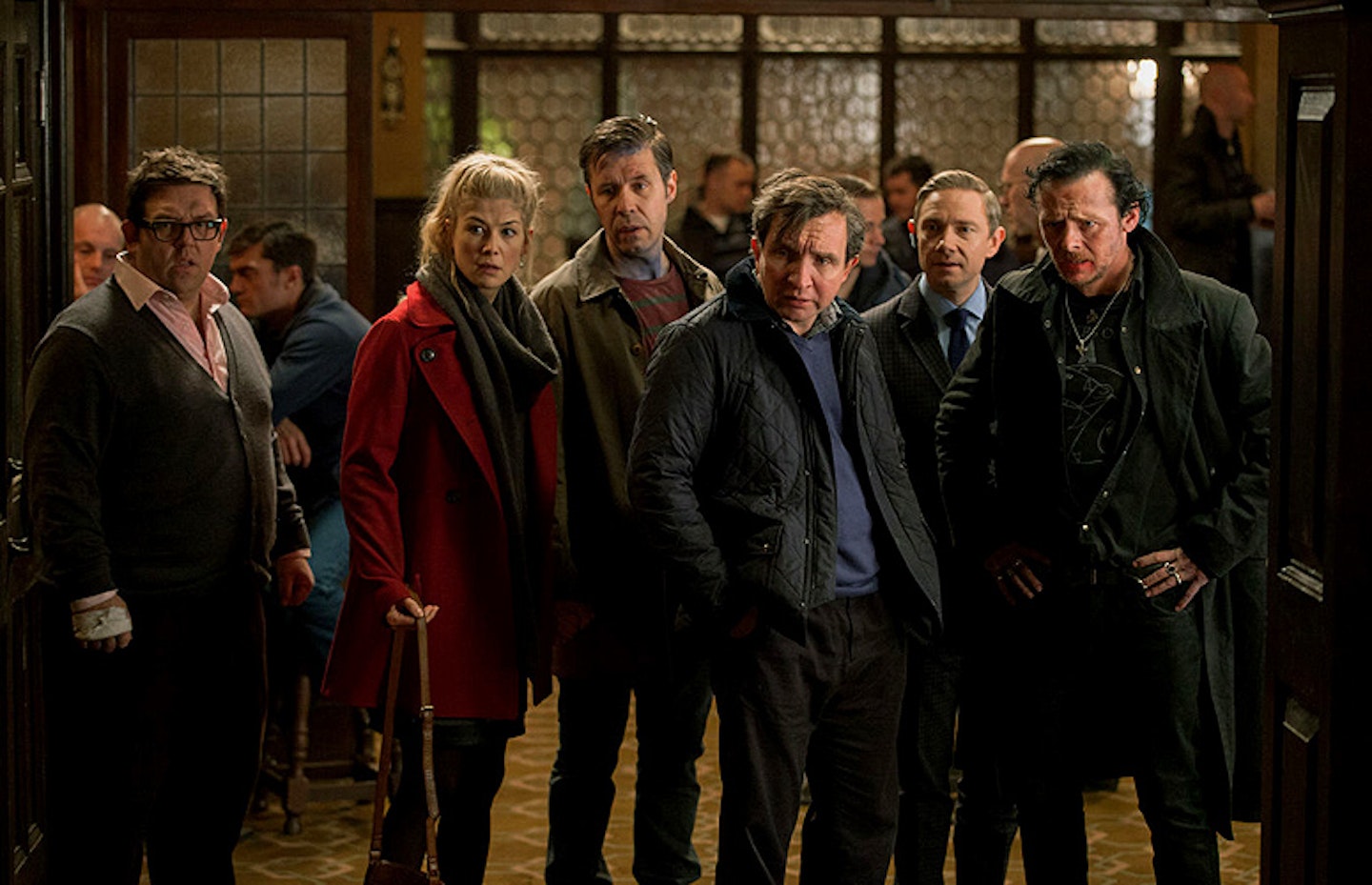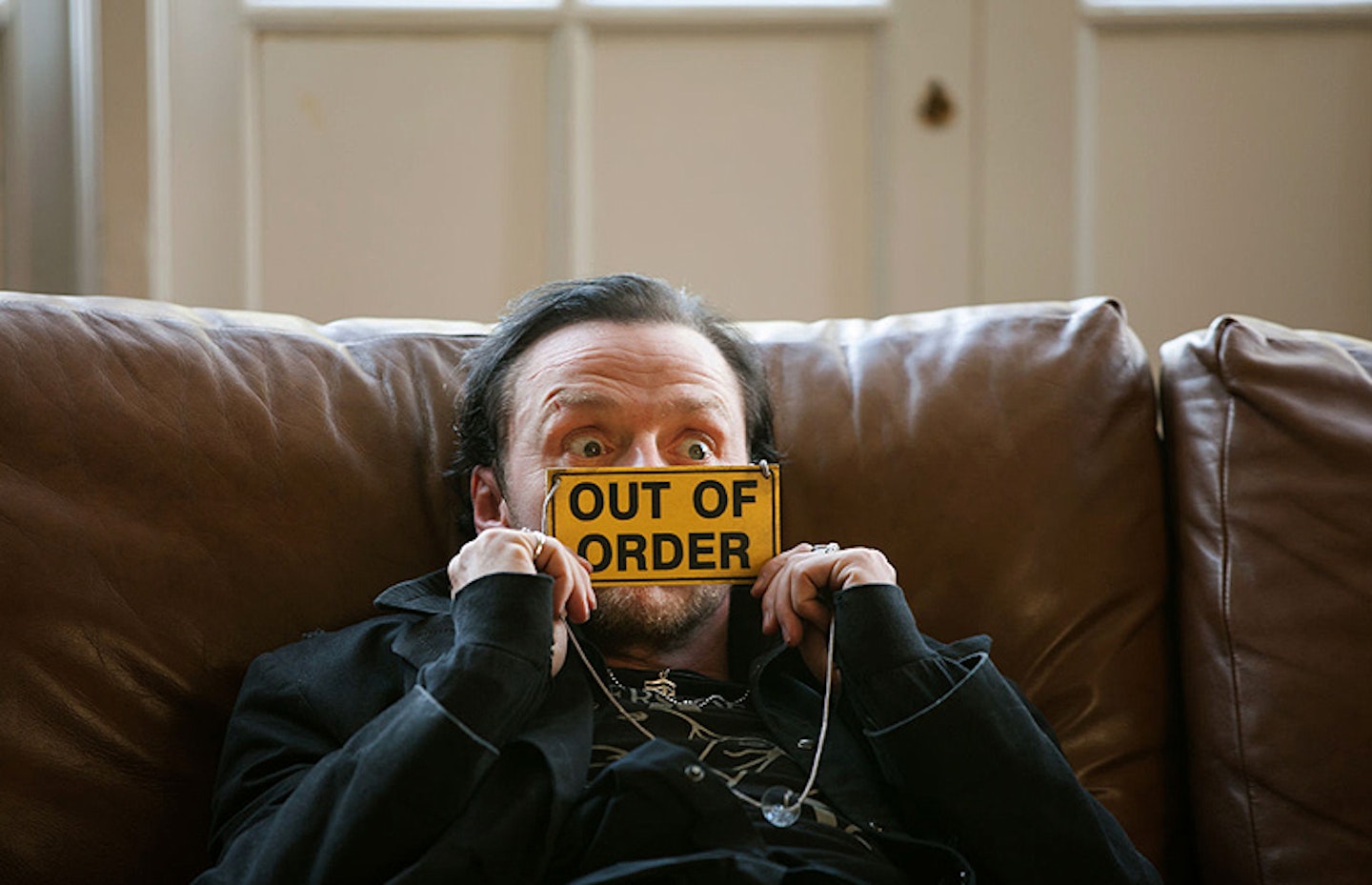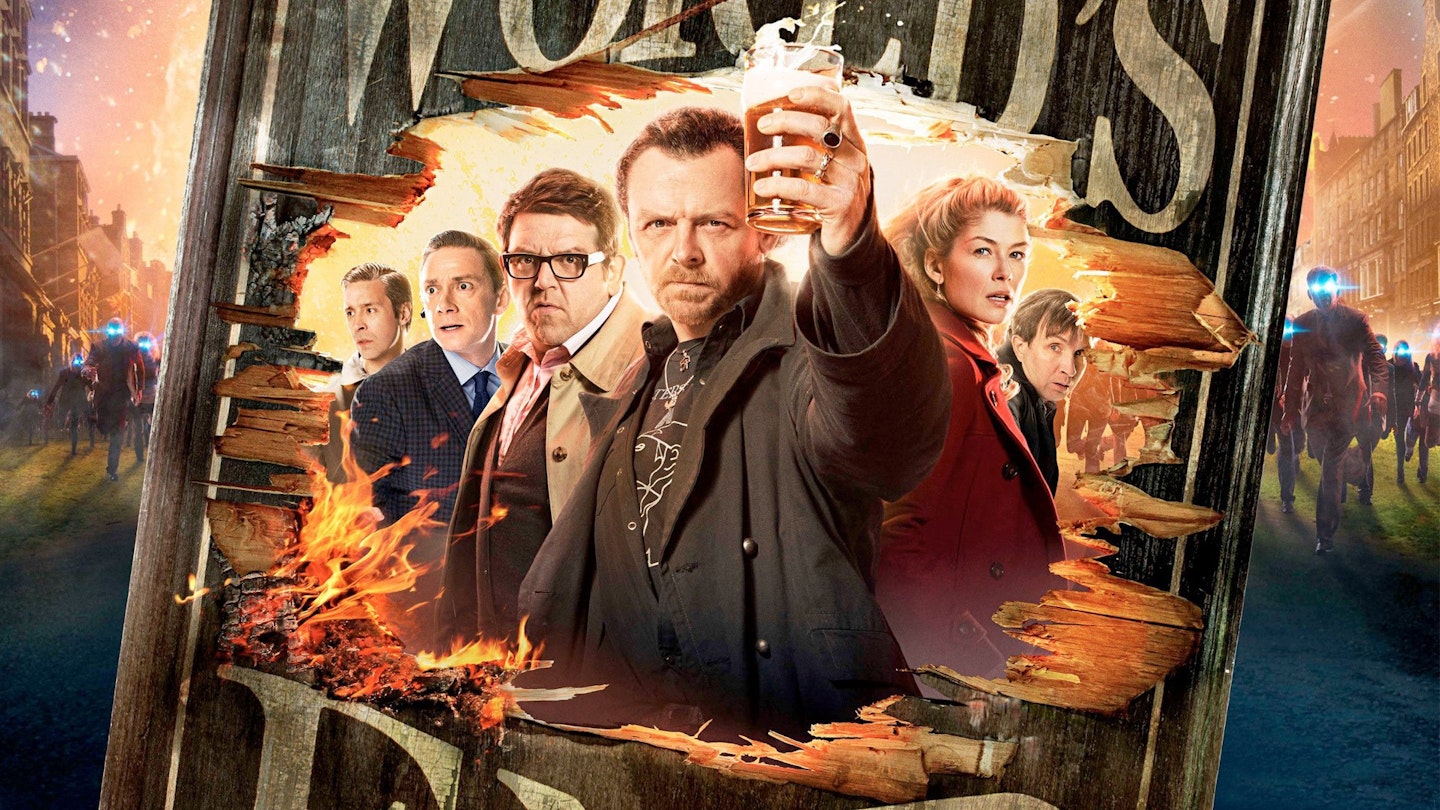
Location: Elstree, London. December 2012.
“YOU'VE GOT BLUE ON YOU”
And it’s true. Simon Pegg does have blue on him. It’s on his hands. It’s on his clothes. It’s even smeared down his face. It’s virtually the first thing Empire notices when Pegg walks onto the set of The World’s End (the George Lucas Stage, no less; wifi network GLucas02) and comes over to say hello. Even more so than his decidedly un-Peggian Gothified get-up of dyed black hair, long black leather coat and black accoutrements, it’s the blue. Immediately, we deliver our witty bon mot - a somewhat apt Shaun of the Dead reference - wait for the laughter. And Pegg does laugh, but in a way that makes us realise that he’s heard that before. Several times. More than that.
“Not as many as you’d imagine, actually,” he reassures Empire. “I know it’s going to be a question we get asked. ‘Why didn’t you put say, ‘you’ve got blue on you’? It’s obvious. That’s why we didn’t do it, because it is obvious.”
Ah. Away from the obvious, the blue, as it turns out, is what’s inside the dark and sinister foes that Pegg and his cohorts find themselves up against in The World’s End, the third, final and very minty instalment of his and Edgar Wright’s Three Flavours Cornetto trilogy, following Shaun of the Dead and Hot Fuzz. “It’s slightly Bravehearty as well,” adds Pegg. “It’s got a woad feel to it. Towards the end of the film I have a blue smudge and a red smudge, and I look absolutely insane!”
But we’re getting ahead of ourselves. Before we can explore The World’s End’s end, we must go back to The World’s End beginning.
Which takes us back many years. Edgar Wright is 21 years old, living in London. He has just finished his first film, the comedy Western A Fistful Of Fingers (one star, says Empire magazine), and knocks together a script called Crawl, about a group of friends who go on an epic pub crawl. He gets “waylaid doing TV stuff” and Crawl crawls into a drawer, where it’s forgotten about…
Until 2007. Pegg and Wright are on the Hot Fuzz promotional trail Down Under. Superbad is the hot comedy of the moment, and its success and youthful vibrancy makes Wright think of his Crawl script. “If I did anything with it, people would assume I was just doing Superbad. Unless…” And, even as he relays this tale to Empire, we can almost see the lightbulb go on over his head. “What if the first five minutes was the end of another film, and the actual movie is about what happened later? I said to Simon, what if the movie was about them reconvening and trying to do the pub crawl again? And at a certain point you throw something very strange into the mix, but the film continues to be about that quest.”

AND SO CRAWL BEGAT THE WORLD'S END, in which five childhood friends - Pegg’s Gary, Nick Frost’s Andy, Paddy Considine’s Steve, Martin Freeman’s Ollie and Eddie Marsan’s Peter - reunite to try to complete the pub crawl that tore them apart 20 years earlier. One mile, one night, twelve pubs from The First Post to The World’s End. There’s only one problem (and here’s that something strange Wright was talking about): the world may actually be ending, as the guys find themselves in the midst of a large-scale attack of seemingly extra-terrestrial origin, hemmed in on all sides by menaces who appear to be human, but clearly are not, with bright, shining lights where their eyes should be and blue ink where their blood should be.
Which brings us back to the George Lucas Stage. Over the past few weeks, it’s played home to most of the pubs Pegg and Wright have cooked up for the film, but today - with just a week left of principal photography - we’re at the business end of things. Just two pub sets remain: The World’s End itself (about which we can tell you nothing, except it has blue carpet, and serves Winshere Cider, a brand made up for the film) and the penultimate pub, The Hole In The Wall.
In a happier, simpler time, this might have been a nice Wetherspoony-type place. A sign on the wall proclaims it to be ‘Newton Haven’s finest’ (Newton Haven being not only the name of the town in which the movie takes place, but also the film’s working title, designed to throw nosy parkers off the scent). Trophies and old cups line one shelf. There’s room for a band. And there’s Nick Frost, in glasses and a pink shirt that’s mottled with blue, battling a horde of bad guys with just an umbrella, some nifty moves courtesy of fight choreographer Brad Allen, and raw fury. It’s a complicated scene, and the umbrella occasionally breaks, but Frost deploys what has become known as pub-fu, twisting and banging his assailants - who have light rigs attached to their faces, which will be replaced with a CG glow later - against the wall, forcibly ejecting them before barring the door. Wright watches on the monitors, beanie cap tight around his face, which is almost pressed up against the glass, body ducking and diving with each forceful Frost move. One take sees a window tinkle to the ground. “Good smash!” cries Wright.
“Brad calls me the white Sammo Hung,” beams Frost later, braving the freezing December day in just his salmon shirt. “Every time he does it, my chest swells.” Counting Spaced, this is the fifth time that Frost and Pegg have appeared on screen as best friends, but the former is adamant that this time it’s different. “Andy’s clued up, he’s successful,” he says. “I’m really angry in this all the way through, too, which is different. I start off as a lawyer and then become Pink Hulk. That’s an idea for a spin-off film. They haven’t done a Pink Hulk.”

AND WHAT OF THE DYNAMIC BETWEEN PEGG AND FROST, the perpetual BFFs on screen and off? “We just fucking hate him,” admits Frost. “I think I hate him, and I feel sorry for him.” Now that is different, but as the scene unfolds it’s easy to see why. For, as Andy risks life and limb to fend off the attack, Pegg’s Gary King simply stands by the bar and tries to down a pint as quickly as he can. It would seem that it’s not just Gary’s appearance that’s different - Pegg is playing a character unlike any he’s done before, a reckless, mouthy, shifty bullshit artist whose life seems to be in a perpetual downward spiral. “That’s the film in a nutshell,” laughs Wright. “Two of your main characters have very different goals. Gary is trying to cling to something that is long gone. Even though I think this has as much, if not more, comedy and craziness and action than Shaun and Hot Fuzz, the themes are a little bit deeper. There’s a tragicomic idea of trying to cling onto your childhood. Gary’s the hero of the movie, and also the villain, but I hope that people find themselves rooting for him against their own better judgement. You want to see him do alright.”
Today, Pegg doesn't have much to do except a reaction shot as something - or some_one_ heads towards the pub. (“It’s the most literal one of them all,” teases Wright of the pub’s name which, like all the pubs, corresponds in some way to the action contained within) Later, he’ll go through a window but, as he’s nursing a dodgy hand, he won’t be doing that. So he retires to his dressing room to wipe off the blue and have a natter with Empire. “The film’s really about a guy facing a dreadful mid-life crisis that’s made even worse by an apocalyptic alien invasion,” he says. “We wanted to make this a very fun, watchable mid-life crisis comedy for part of the film, so when the threat comes in you realize that the film isn’t about the threat, it’s an exacerbation - whatever that means - of the problems that are already in place.” Hey, we’ll do the Shaun references around here, thank you very much.
“The nature of the threat ended up shaping the entire thrust of the movie,” continues Pegg, “which is the homegenisation of little places, whether that be a coffee shop that gets turned into Starbucks, or Earth. Gary’s a metaphor for Earth, basically. That’s a big character to play…”
This article appeared in the July 2013 issue of Empire magazine. Subscribe to Empire magazine{
